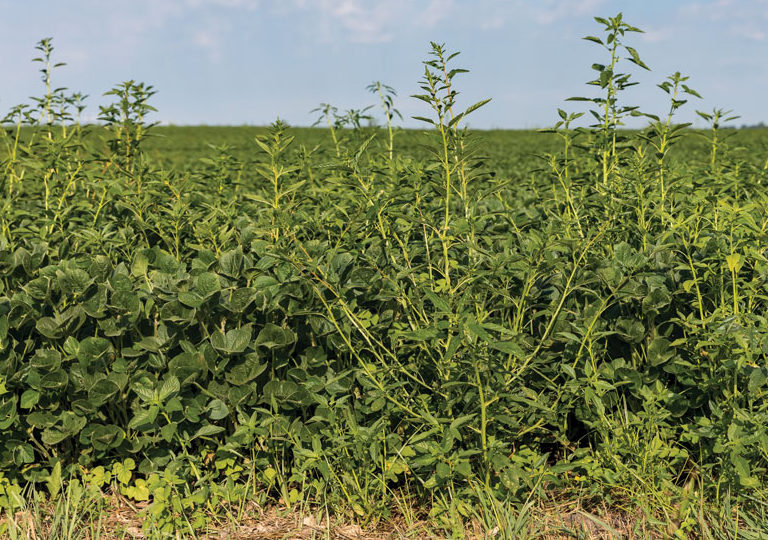Pictured Above: WAYWARD WEEDS. Herbicide-resistant waterhemp is a stumbling block for farmers who want to grow non-GMO soybeans, as much of it is resistant to ALS inhibitors, glyphosate and PPO inhibitors, the primary herbicide options that would normally be used to combat them.
The increasing incidence of herbicide-resistant weeds is a headache for many no-tillers, but for those trying to deliver product for the growing non-GMO market, it’s especially challenging.
Mark Loux, a weed specialist with Ohio State University Extension, says developing a good weed management program is key to successfully no-tilling non-GMO crops, especially soybeans.
“Non-GMO corn is actually pretty easy,” he said during a presentation at the 2021 Conservation Tillage and Technology Conference. “The full complement of broad-spectrum herbicides can be used, just like in transgenic corn.”
The only difference with corn, he says, is glyphosate and glufosinate can’t be used in a post-emergence application, and Enlist Duo and Enlist One products can’t be applied later at the higher rate like could be done with Enlist corn.
“But you have all the same broad spectrum, residual herbicides, and a lot of very good pre-mixes,” he says. “And you can also make your own mixes because most of these products are made up of generic components at this point.”
Susceptible Soybeans
Non-GMO soybeans, on the other hand, are much more difficult to manage because of a handful of problematic weeds — marestail, waterhemp, giant ragweed and common ragweed — that have developed resistance to many weed control options.
When looking at herbicide resistance in Ohio, Loux says in almost all cases (see Chart 1 at top of page), these weeds are resistant to Group 2 herbicides (ALS inhibitors) as well as Group 9 (glyphosate). Glyphosate, of course, can’t be used post-emergence in non-GMO soybeans, but would often be part of the burndown program, he adds, so glyphosate resistance needs to be factored in.
“We have a lot of glyphosate resistance and the bottom line is if you have these weeds, you have to assume they’re ALS resistant too, or will be soon. So that leaves you with PPO inhibitors as your main post-emergence options, and if you develop resistance to those [in a conventional system], you’re basically out of the non-GMO business.”
Field Prep
While growing non-GMO soybeans is a challenge, it’s not impossible if proper field preparation is done, says Loux. To improve your chances of success, “you want to come into it with several prior years of effective weed control using the new herbicide trait systems, and drive the weed seed bank down so you don’t have anything that gets out of control.”

GROWING RESISTANCE. In the state of Ohio, researchers are finding increasing instances of herbicide resistance in marestail, giant ragweed, common ragweed and waterhemp. Farmers with any of these weeds will need to do some extra planning and management in order to venture into non-GMO soybeans production.
Once you have control of the fields, Loux recommends growing non-GMO soybeans only every fourth year or so. He suggests growing a couple of years of corn or some wheat, then one year of a GMO soybean, “so when you plant the non-GMO soybean the post-emergent PPO inhibitors will remain viable.”
Non-GMO Success
For the non-GMO soybean part of the rotation, Loux recommends both a fall herbicide treatment as well as a spring burndown, residuals and post-emergence treatments. The fall treatment — which is critical for managing marestail — should consist of 2,4-D plus glyphosate or dicamba (or Canopy or other ALS inhibitor).
“Almost everybody has some marestail, which is always an issue in a burndown. You can get it in a burndown, but it’ll have to be a more aggressive program. And if you don’t get it in that spring burndown it’s going to come back and really cause problems,” he says.
Following a fall treatment, the spring burndown “can be almost anything,” says Loux, such as:
- Glyphosate plus 2,4-D (wait 7 days to plant
- Glyphosate plus a saflufenacil product (Sharpen, Verdict or Zidua PRO)
- Gramoxone (2-3 parts) plus 2,4-D (works better with metribuzin added)
- Glufosinate plus 2,4-D (works better with metribuzin added)
- Glufosinate plus metribuzin
If the fall burndown wasn’t done, the spring burndown will need to be more aggressive, as in the following suggestions:
- Glyphosate plus 2,4-D and a saflufenacil product (Sharpen, Verdict or Zidua PRO)
- Glyphosate plus 2,4-D and glufosinate
- Gramoxone (3-4 parts) plus 2,4-D and metribuzin
- Glufosinate plus 2,4-D and metribuzin
- Glufosinate plus Sharpen and metribuzin
Residual and post-emergence herbicides will be dependent upon the weeds present because of the different types of resistance they exhibit.
In the case of marestail infestations, there are no post-emergence options — it must be controlled with a fall and spring burndown and residual herbicides. “But you need to make sure to pick the right residual combination or pre-mix to get control,” he says, adding that typically would involve mixing metribuzin plus flumioxazin or sulfentrazone or a product that has both of those herbicides in it.
“Our research shows that combinations are more consistently effective than any one product, based on the variability of herbicides and the fact that none of these are terribly long lived herbicides.
“So our main recommendation is either a tank mix or a pre-mix that contains decent rates of metribuzin — about a 0.38 pound rate of metribuzin — with flumioxazin or sulfentrazone or a high rate of metribuzin with Sharpen.”
For giant ragweed, Loux says the residual program will need to have “FirstRate or Classic in it, or Pursuit can help out. If you have ALS resistance, none of those are going to work and you’ll have to rely on the post emergence program.”
A PPO inhibitor is the only post-emergence option and Loux says one application generally isn’t enough. “The mistake a lot of people make is trying to get by with one post application,” Loux says.
“On giant ragweed, fomesafen (Flexstar), Cobra and all the generics, are really only about 85% effective at best. We’ve been able to control nasty populations with two applications, using fomesafen as a first post-emergence application followed three weeks later by an application of Cobra. If you don’t take that approach, I think you’re really going to struggle.”
If ALS resistance is present with common ragweed, Loux says the only residual products available are “flumioxazin (Valor), which is fair-to-good, and metribuzin, which is poor-to-fair.” If the common ragweed hasn’t developed resistance to PPO inhibitors, growers can use fomesafen (Flexstar) and Cobra as a post-emergence application.
“Typically fomesafen is 10-15% better than Cobra in a post application,” Loux says. “But once you do develop PPO resistance, which is always in conjunction with ALS resistance, you have no post options and the only residual option you have is metribuzin, which would not be very good, so you’re out of the non-GMO business at that point, unless you can drive those populations way down.”
For waterhemp, Loux says there are a lot of pre-emergence options, but your only post-emergent PPOs are fomesafen (Flexstar) and Cobra. As with common ragweed, once PPO resistance has developed, non-GMO soybeans are no longer a viable option.
“It’s really difficult to recommend growing non-GMO soybeans in a field that’s infested with waterhemp,” he says.
Loux’s final key recommendation is to make sure the first post-emergence application is made when weeds are small — ideally less than 4 inches tall, but certainly no more than 6 inches tall — and to do a second post application as needed, which will definitely be needed for giant ragweed.
Bottom line, it’s critical to prevent the weeds from getting too big “and don’t try to get by with just one application. I can’t emphasize the value of the fall herbicide treatments enough,” says Loux.







